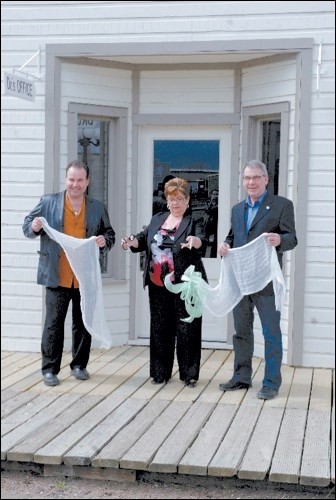Attracting and retaining doctors is a big issue in Saskatchewan today, but at the turn of the century, it was an even bigger dilemma, with both doctors and druggists few and far between.
The Western Development Museum in North Battleford paid homage to this essential aspect of life in the early 20th century, as they celebrated the grand opening of a doctor's office and drug store in the Heritage Farm and Village, May 17.
A previous doctor's office and drug store at the WDM had been built in the 1980s, but didn't stand the test of time, being closed to the public in 2007 due to floor failure.
Almost 2,000 artifacts were removed from the old building in 2009 and the new building was completed by last summer.
Over the winter months, North Battleford WDM staff members were busy restoring the many artifacts, and this spring they were joined by staff from Saskatoon WDM and the curatorial centre to complete the project.
Collections Curator Ruth Bitner shed light on the importance of the display as she spoke to the crowd gathered for the opening ceremony.
"The opening of a drug store was welcome in small communities where people often had only home remedies to treat wounds or illnesses," said Bitner. "The drug store in the 1920s was a place of wonder - there were lotions and potions and patent medicines meant to cure everything from catarrh to cramps."
Bitner explained doctors, who in general had made the shift from horse and buggy (or horse and sleigh in the winter) to cars by the mid 1920s, spent much of their time on house calls.
"I recently read about one doctor who made 426 calls in the country in a single year," said Bitner.
She described how doctors could be paid with farm goods, such as eggs or beef, if a patient was short in cash, and pointed out Saskatchewan is the birthplace of publicly funded health care.
The small town of Holdfast, about an hour northwest of Regina, had a bad year of crops in 1915 and were about to lose their doctor, as the townsfolk were unable to pay for medical services. To prevent this, the rural municipality paid the doctor a retainer of $1,500.
"This was the first time in North America that tax dollars were used to pay a doctor," said Bitner. "The idea caught on and by 1927, there were 13 municipal doctors in towns like Beechy, Chamberlain and Senlac."
Bitner added the dirty 30s saw a further increase in the number of municipal doctors with a guaranteed annual salary.
Bitner also described the differences between today's pharmacies and the drug stores of yesteryear, saying merchandise was kept behind the counter or in glass cases, as opposed to being on shelves where customers could help themselves, and prescriptions often required pharmacists to mix a number of ingredients with a mortar and pestle to make ointments, elixirs or liniments.
"And during prohibition, when bars were closed, the druggist could legally sell liquor, for medicinal purposes only, of course," said Bitner.
Mayors Chris Odishaw and Ian Hamilton attended the grand opening, with both speaking of the importance of the WDM to the community and in attracting tourists to the region.
After the ribbon cutting ceremony, attendees were invited to tour the new exhibit and were treated to refreshments in the Tea Room, which is a replica of the old Board and Trade Building.




